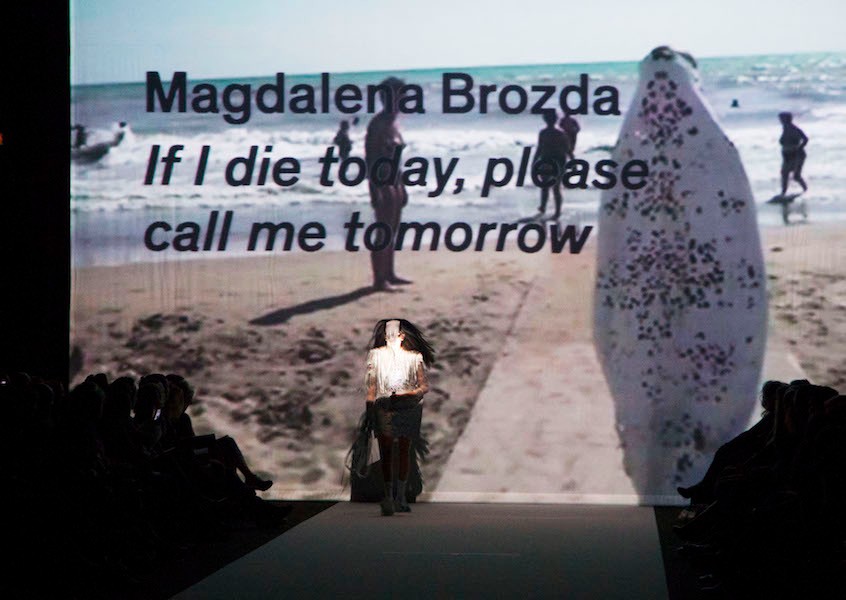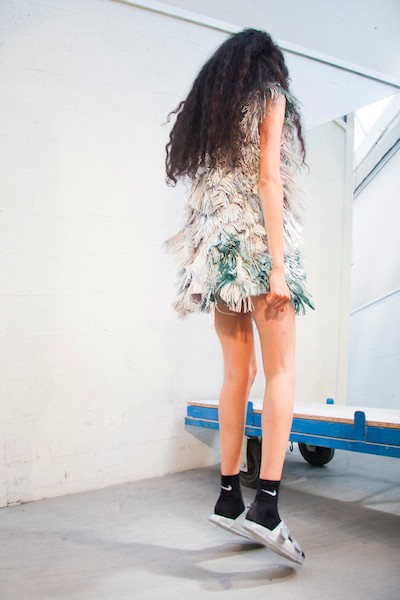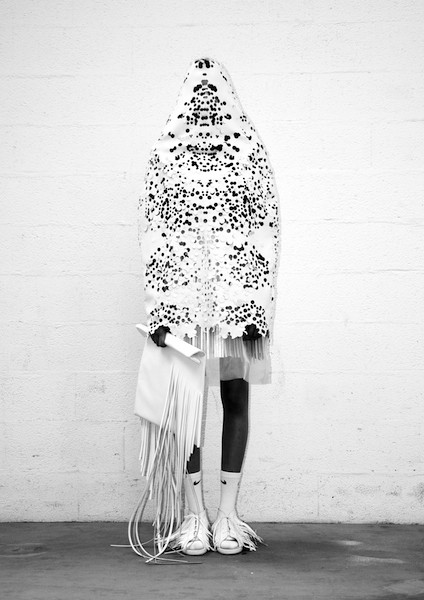Polish designer Magdalena Brozda was awarded with the ‘Master of Fashion & Accessory Design’ at HEAD Genève for her current collection ‘If I Die Today, Please Call Me Tomorrow’. The collection redefines sinister visions of death, making them more festive and fun. She was also a finalist for the ‘H&M Design Award’ 2015. Magdalena Brozda was chosen by HEAD Genève to showcase her work in the CH-Talents Visionaries exhibition as part of the 2015 International Fashion Showcase at LFW.
Magdalena, why did you title your collection ‘If I Die Today, Please Call Me Tomorrow’?
Death is the main source of inspiration for this collection. This subject is very often avoided or seen as something negative, sinister and scary. Through my research and final results, I wanted to communicate my personal vision of death as more bright, dreamy and positive and imagine my last days as a surreal party with death, using this as the basis for the visual framework of my collection. I was looking for a title based on incoherence and irony. Something that sounds almost like a slogan and publicity advertisement or ambiguous text message. The title was a first step to desecrate this subject.
One could take that as a hint at new advances in technology and how we’re constantly on our phones, and always on to the next thing. What message are you trying to send?
This collection is not really intended to convey a global message, but it’s true that I’m not always comfortable with the artificial aspect and constraints created by modern ‘connected’ life. The title therefore also refers to the fact that during my imaginary meeting with Mrs. Death, I would leave behind me all those trivial life aspects.
You talk about the celebration of death with confetti, yet your garments seem slightly sinister with the different textures and materials used – what was your intention?
In my collection, narration has a very important place. I wanted to create my own vision of a celebration of death based on incoherence and confusion, where I redefined the current gloomy vision of death by drowning it in my more optimistic and bright childhood visions. Every single element in the collection has its significance for me. The holes in the leather could evoke a skin pierced by bullets, meaning that the body is a target. The pieces in darker colours are more or less linked to my macabre and sinister sentiments. The white leather and paper confetti of different sizes are linked to celebration. The fringes are references to festive and positive images I’ve associated with death since I was young. Incoherence and confusion are the pillars of the collection: I wanted to assembly elements that have nothing to do with each other, like hospital shoes, Nike socks, little girls’ dresses, and to mix unconventional materials, such as leather, paper, organza, in order to create an aesthetic reflecting my vision of death celebration; without rules and limits.
How do you use film and photography to create your ‘own universe’?
Photos and videos are essential for me. I use them to transpose the personal universe, to create the visual language and a sort of narration. It’s also my method of design process. Texts, photos and videos created throughout the project form the aesthetic universe of the collection, the conceptual framework. They’re also a direct source of inspiration: Video clips, for example, were used as moving patterns for certain garments.
How has HEAD helped change the way you look at fashion?
HEAD allowed me to discover and develop my own point of view on fashion. It’s not a school that formats the students or forces them to adapt to their style or aesthetic. I was totally free and very well guided. I owe a lot to my tutor who helped me to discover my artistic language and encouraged me to push the limits.
Fashion in London is very much influenced by nightlife, clubbing and streetwear. How is that different in Genève? What inspires fashion there?
Geneva is often presented as a boring place where nothing happens. That’s not true! For me this city has a huge creative energy and potential, favoured by a strong alternative culture. My friends are musicians, photographers, painters, film directors, and they are extremely inspiring. In Geneva we find less extravagance on the street, but lots of things happen in galleries or other places where media and the arts cross over. In Geneva, fashion seems primarily influenced by art.
Why did you choose to study fashion?
Everything in my life is kind of an accident, which I call destiny. I came to Switzerland to study international relations, but finished at art school, and I’m more than happy about my choice. Fashion has been my passion since I was small and since I discovered that clothes could become a medium of artistic expression. I choose to study this domain to create and discover new techniques and explore the limits between art, fashion and design.
How would you define beauty?
For me, the definition of beauty doesn’t exist. I can say that I am attracted by ambiguity, strangeness, rarity and weirdness, which can be read as my personal definition of beauty.
Still or sparkling?
Sparkling.
Interview: Misha Skelly
CH Talents: Visionaries
Emerging Swiss Fashion Design
20-24 February 2015
Display Gallery
26 Holborn Viaduct
London
EC1A 2AT











